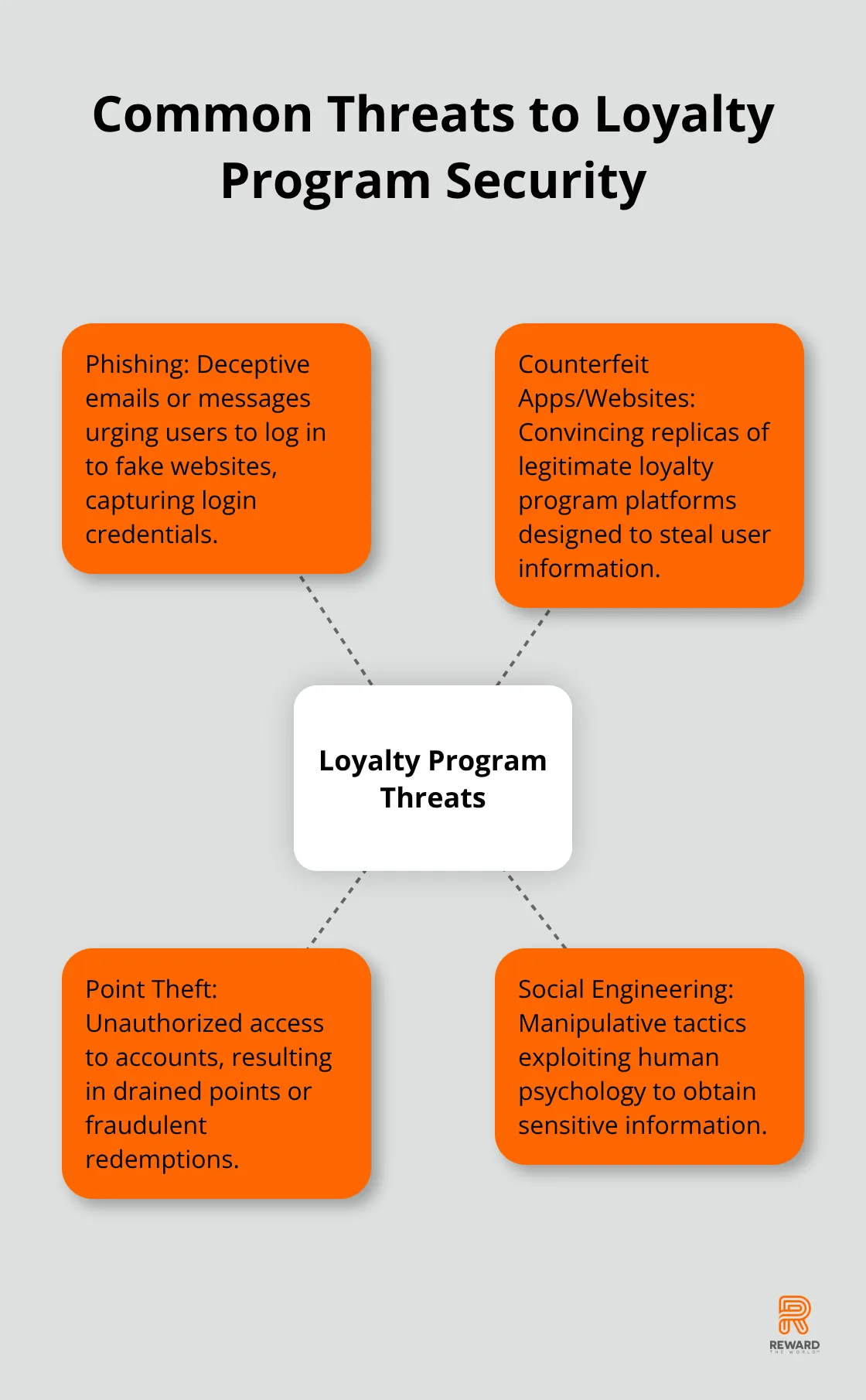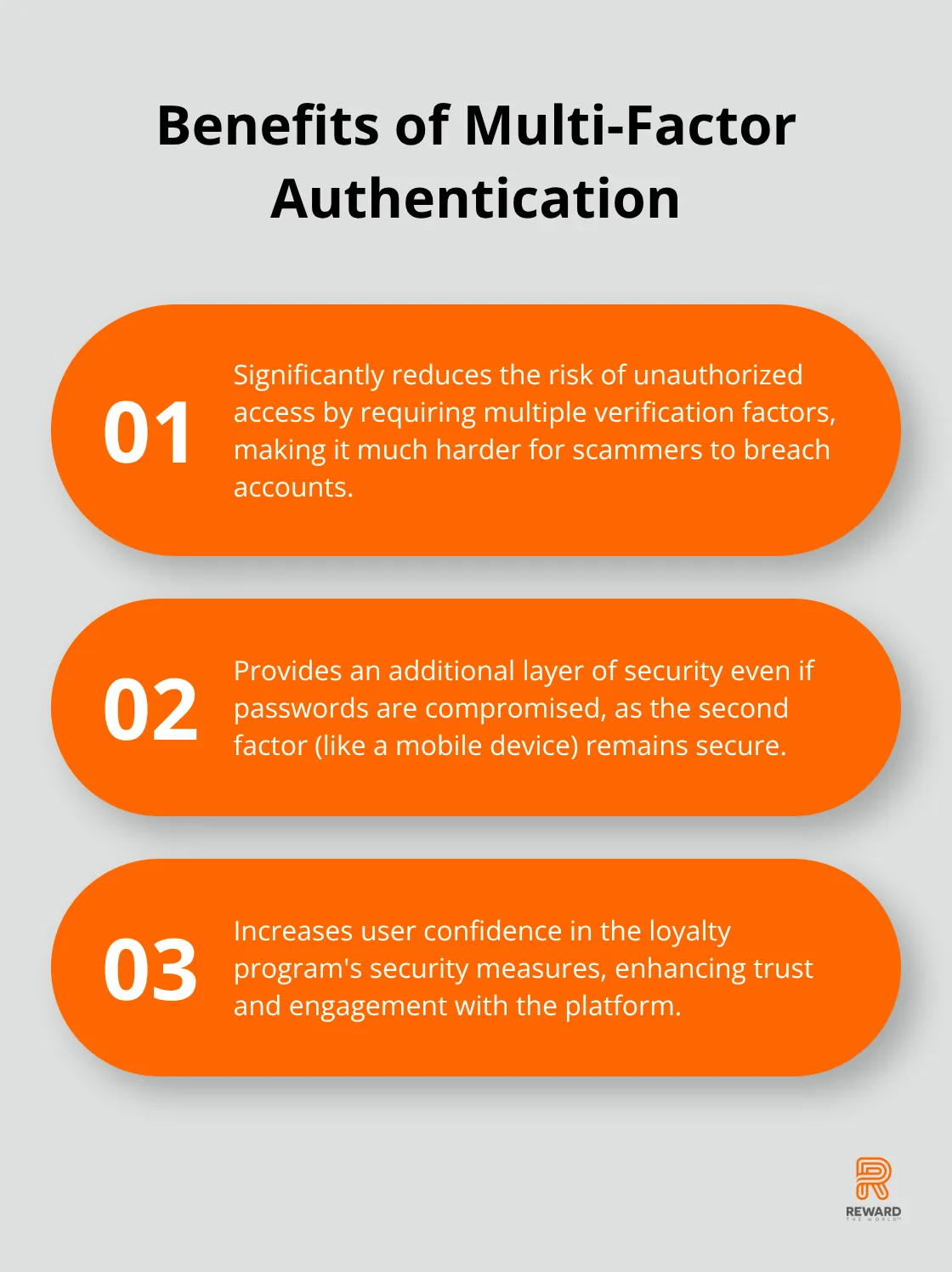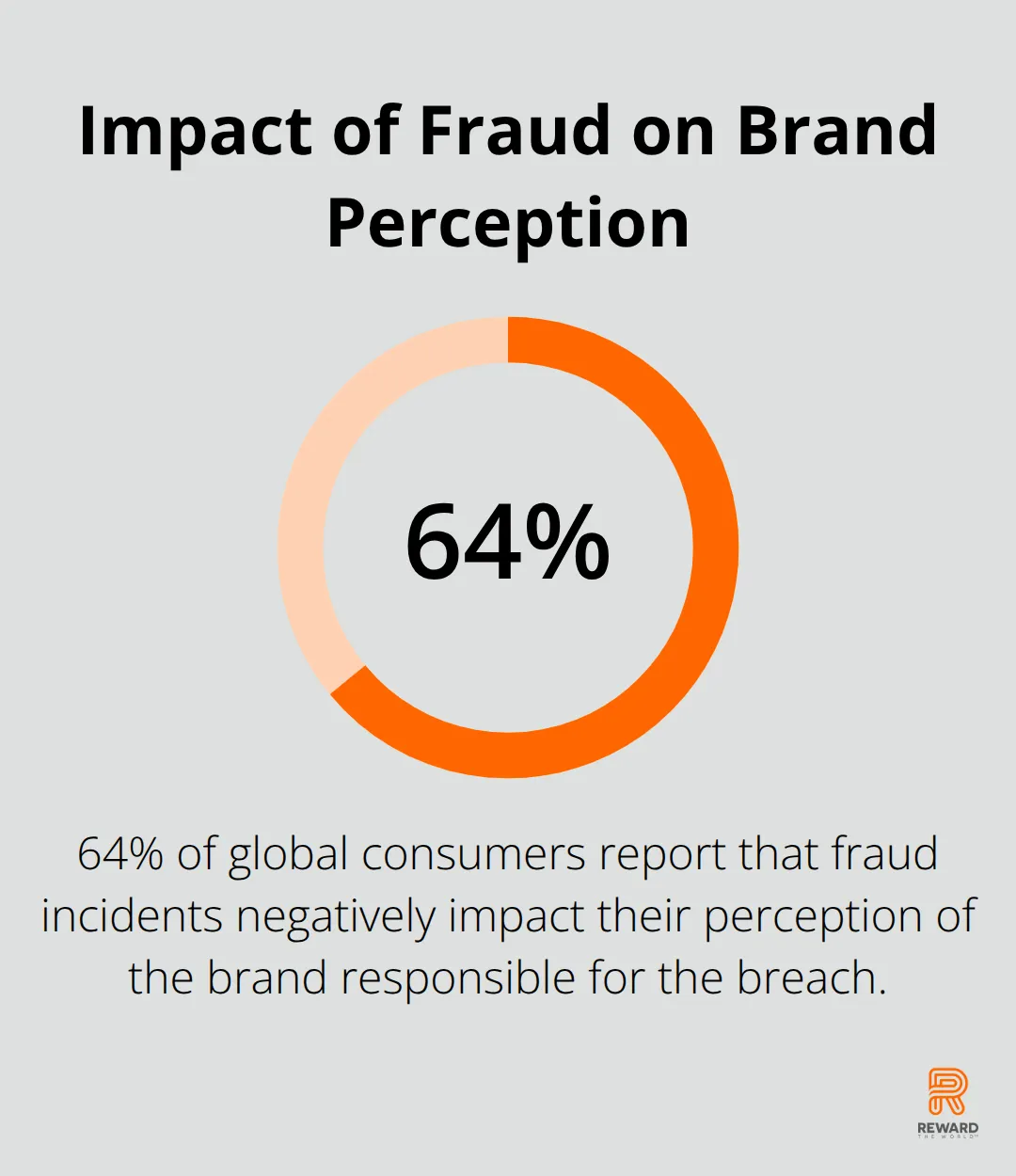
Digital loyalty programs are increasingly targeted by scammers, putting both businesses and customers at risk. At Reward the World, we’ve seen a rise in loyalty fraud attempts, from sophisticated phishing attacks to point theft schemes.
Staying ahead of these threats requires a combination of technological safeguards and user education. This post will explore common scams, protective measures, and best practices to keep your loyalty program accounts secure.
How Scammers Target Digital Loyalty Programs
Digital loyalty programs have become prime targets for scammers, with fraudsters employing increasingly sophisticated methods to exploit these systems. Let’s explore some of the most common tactics used by scammers.
Phishing: The Bait and Switch
Phishing attacks remain one of the most prevalent threats to loyalty program security. Scammers send emails or text messages that appear to be from legitimate loyalty programs, urging users to log in to their accounts or update their information. These messages typically contain links to fake websites designed to capture login credentials.
To protect yourself, always verify the sender’s email address and avoid clicking on links in unsolicited messages. Instead, navigate directly to the loyalty program’s official website by typing the URL into your browser.
Counterfeit Apps and Websites
Fraudsters create convincing replicas of legitimate loyalty program websites and mobile apps to trick users into entering their account information. These fake platforms often promise exclusive deals or bonus points to lure unsuspecting customers.
Before downloading any loyalty program app, check the official app store and read user reviews. For websites, ensure the URL is correct and look for security indicators like HTTPS in the address bar.

Point Theft and Unauthorized Redemptions
Once scammers gain access to loyalty accounts, they often drain points or make unauthorized redemptions. This can happen through various means, including account takeovers or exploiting vulnerabilities in the program’s infrastructure.
To mitigate this risk, monitor your account activity regularly and enable notifications for point redemptions. If your loyalty program offers it, set up two-factor authentication for an extra layer of security.
Social Engineering: The Human Element
Social engineering tactics exploit human psychology to manipulate individuals into divulging sensitive information. Scammers might pose as customer service representatives, claiming there’s an issue with your account that requires immediate attention. They may use pressure tactics or create a sense of urgency to bypass your usual caution.
Be wary of unsolicited calls or messages about your loyalty account. If in doubt, hang up and contact the company directly using their official customer service number. Legitimate companies will never ask for your full password or sensitive personal information over the phone or email.
Understanding these common scams empowers you to better protect your loyalty program accounts from fraudsters. Stay vigilant, keep your personal information private, and report any suspicious activity to your loyalty program provider immediately.
Now that we’ve covered the tactics scammers use, let’s explore the technological safeguards that loyalty programs (like Reward the World) implement to protect their users from these threats.
How Loyalty Programs Protect Your Data
At Reward the World, we prioritize data security. Our platform, like many advanced loyalty programs, uses cutting-edge technologies to safeguard user information and prevent fraud. Let’s explore some key technological safeguards used in modern loyalty programs.
Multi-Factor Authentication: Your First Line of Defense
Multi-factor authentication (MFA) has become a standard security feature in many digital services, including loyalty programs. This system requires users to provide two or more verification factors to access their account, which significantly reduces the risk of unauthorized access.
For example, after you enter your password, you might need to input a code sent to your mobile device or email. Some programs even use biometric data like fingerprints or facial recognition for added security. A study by Microsoft investigates the effectiveness of multifactor authentication in protecting commercial accounts from unauthorized access.

AI-Powered Fraud Detection: Spotting Unusual Activity
Artificial Intelligence (AI) and Machine Learning technologies are rewriting the rulebook for loyalty programs. From predictive analytics to real-time personalization, these systems analyze vast amounts of data, identify patterns, and flag suspicious activities that might indicate fraud.
For instance, if a user suddenly redeems a large number of points from an unusual location, the AI system might flag this as potential fraud and temporarily freeze the account pending verification. This proactive approach prevents unauthorized redemptions before they occur.
Blockchain: Securing Transactions and Points
Some loyalty programs explore blockchain technology to enhance security and transparency. Blockchain is transforming customer loyalty programs by enhancing transparency, security, and engagement.
While still in its early stages for loyalty programs, blockchain has the potential to revolutionize how programs track and redeem points. It could also facilitate seamless point transfers between different loyalty programs, enhancing user experience while maintaining security.
Regular Security Audits: Staying Ahead of Threats
Loyalty programs must constantly evolve to stay ahead of sophisticated scammers. Regular security audits and penetration testing help identify vulnerabilities before fraudsters can exploit them.
These audits often involve ethical hackers who attempt to breach the system’s defenses, simulating real-world attack scenarios. Programs promptly address any weaknesses discovered, which ensures that security measures remain robust and up-to-date.
While these technological safeguards provide strong protection, user vigilance remains essential. In the next section, we’ll discuss how you can play an active role in securing your loyalty program accounts (and why it’s so important).
How to Outsmart Loyalty Program Scammers
At Reward the World, we believe that user education plays a key role in the fight against loyalty program fraud. While we implement robust technological safeguards, your vigilance remains equally important. Here’s how you can protect yourself from scammers targeting your hard-earned rewards.
Recognize Red Flags
Scammers often leave telltale signs in their communications. Be alert to emails or messages that create a sense of urgency or threaten account closure. Legitimate loyalty programs rarely demand immediate action. Also, watch for poor grammar or spelling errors, as these often appear in phishing attempts.
Even if a retailer doesn’t actively misuse your data, selling or sharing your profile with data brokers can expose seniors to spam, scams, or price discrimination. Don’t become part of this statistic. If an offer seems too good to be true, it probably is. Always verify communications by contacting the loyalty program directly through their official channels.
Create a Strong Password Fortress
Your password serves as your first line of defense. Create simple, clear guidelines on how customers can protect their accounts, such as choosing strong passwords and avoiding sharing sensitive information. A password manager can help you generate and store strong passwords securely.
Try using passphrases instead of single words. For example, “ILovePizzaWithExtraCheese!” provides much stronger protection than “Pizza123”. Also, enable two-factor authentication whenever possible.
Protect Your Personal Information
Treat your loyalty account information with the same care you give to your financial data. Never share your account details, passwords, or personal information over unsecured channels. Exercise caution when accessing your accounts on public Wi-Fi networks, as these can be easily compromised.
A study revealed that 64% of global consumers report that fraud incidents negatively impact their perception of the brand responsible for the breach. Don’t make it easy for scammers. Review your account activity regularly and report any suspicious transactions immediately.

Report Suspicious Activity Promptly
If you suspect fraudulent activity on your loyalty account, report it without delay. Most loyalty programs have dedicated fraud reporting channels. Quick reporting can make a significant difference.
Your vigilance and prompt action can significantly reduce your risk of falling victim to loyalty program scams. Protecting your rewards requires a collaborative effort between you and your loyalty program provider.
Final Thoughts
Loyalty fraud continues to evolve, challenging both users and program providers to stay alert. Scammers develop new tactics to exploit digital loyalty systems, which emphasizes the need for ongoing education and awareness. We at Reward the World prioritize the protection of our users from these threats through advanced security measures.
User vigilance plays a vital role in combating fraud. We urge all loyalty program members to update passwords regularly, enable multi-factor authentication, and remain cautious of suspicious communications. Treating loyalty accounts with the same care as financial accounts will significantly reduce the risk of falling victim to scams.
Protecting rewards requires a joint effort between users and loyalty programs. We encourage you to stay informed about the latest scam tactics and monitor your account activity closely. For enhanced security and peace of mind, explore our global incentives platform designed to safeguard your hard-earned rewards.
